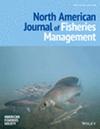Brook Trout population response to Brown Trout removal by electrofishing in a Wisconsin Driftless Area stream
IF 1.3
4区 农林科学
Q3 FISHERIES
引用次数: 0
Abstract
Populations of Brook Trout Salvelinus fontinalis have declined across their native range in North America due to a combination of habitat loss, exploitation, and introductions of nonnative salmonids. Brown Trout Salmo trutta have been widely introduced into streams across Brook Trout's native range and likely displace Brook Trout from suitable habitat. We evaluated the population response of Brook Trout to Brown Trout removal in Maple Dale Creek, a Wisconsin Driftless Area stream, relative to a nearby control stream with similar habitat and sympatric Brook Trout and Brown Trout. Variation in mean July stream temperature (11.6–16.4°C) among survey sites also allowed us to examine whether summer stream temperature was related to the population response of Brook Trout to Brown Trout removal.Between 2019 and 2023, we completed 33.7 km of single‐pass electrofishing during 56 site visits and removed 20,495 Brown Trout from 7.1 km of Maple Dale Creek upstream of an existing fish passage barrier. Concurrently, annual salmonid population estimates were completed on Maple Dale Creek and a nearby reference stream.By 2023, biomass and density of Brown Trout age 1 and older (age 1+) had decreased to 1% or less of 2019 levels. Concurrently, age‐1+ Brook Trout biomass increased by a factor of 5.5 and density by a factor of 9.7. In contrast, age‐1+ Brook Trout density and biomass in our control stream remained low and relatively unchanged. Brook Trout population response to Brown Trout removal was positive across all four sites but exhibited a positive correlation to mean July stream temperature.Our results add to the evidence that Brown Trout displace Brook Trout populations from stream habitat, highlight the utility of electrofishing removal of Brown Trout in restoring Brook Trout populations where downstream fish passage barriers are present, and suggest that Brown Trout suppression of Brook Trout is positively related to summer stream temperature.威斯康星州无漂移地区一条溪流中的布鲁克鳟鱼种群对电鱼清除褐鳟的反应
由于栖息地丧失、开发和非本地鲑鱼的引入,布鲁克鳟(Salvelinus fontinalis)在北美的原生地种群数量已经减少。褐鳟(Salmo trutta)已被广泛引入布鲁克鳟原生地的溪流中,并很可能将布鲁克鳟从合适的栖息地中驱逐出去。我们评估了威斯康星州无漂移区枫树谷溪(Maple Dale Creek)中布鲁克鳟鱼的种群对移除褐鳟的反应,与附近具有相似栖息地、布鲁克鳟鱼和褐鳟同源的对照溪流相比,布鲁克鳟鱼的种群对移除褐鳟的反应更为明显。在 2019 年至 2023 年期间,我们在 56 次实地考察中完成了 33.7 公里的单程电鱼,并从现有鱼类通道障碍物上游 7.1 公里的枫树戴尔溪中移除了 20495 条褐鳟。到 2023 年,1 岁及以上(1 岁以上)褐鳟的生物量和密度下降到 2019 年水平的 1%或更低。同时,1 岁以上的布鲁克鳟鱼生物量增加了 5.5 倍,密度增加了 9.7 倍。相比之下,在我们的对照河流中,1龄以上布鲁克鳟鱼的密度和生物量仍然较低且相对不变。在所有四个地点,布鲁克鳟鱼种群对移除褐鳟的反应都是积极的,但与七月份的平均溪流温度呈正相关。我们的研究结果进一步证明,褐鳟会将布鲁克鳟鱼种群从溪流栖息地中驱逐出去,强调了在存在下游鱼类通道障碍的地方,电鱼移除褐鳟对恢复布鲁克鳟鱼种群的作用,并表明褐鳟对布鲁克鳟鱼的抑制与夏季溪流温度呈正相关。
本文章由计算机程序翻译,如有差异,请以英文原文为准。
求助全文
约1分钟内获得全文
求助全文
来源期刊
CiteScore
2.60
自引率
18.20%
发文量
118
审稿时长
2 months
期刊介绍:
The North American Journal of Fisheries Management promotes communication among fishery managers with an emphasis on North America, and addresses the maintenance, enhancement, and allocation of fisheries resources. It chronicles the development of practical monitoring and management programs for finfish and exploitable shellfish in marine and freshwater environments.
Contributions relate to the management of fish populations, habitats, and users to protect and enhance fish and fishery resources for societal benefits. Case histories of successes, failures, and effects of fisheries programs help convey practical management experience to others.

 求助内容:
求助内容: 应助结果提醒方式:
应助结果提醒方式:


